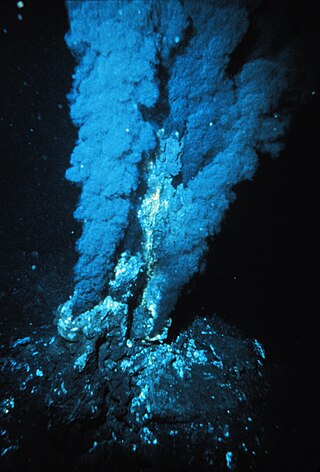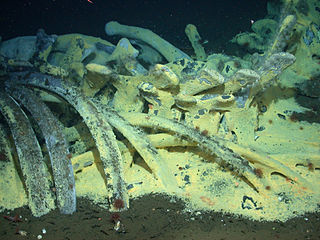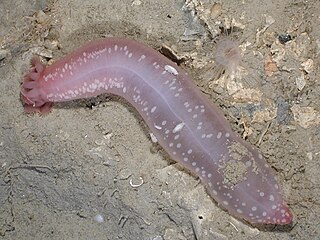
In biochemistry, chemosynthesis is the biological conversion of one or more carbon-containing molecules and nutrients into organic matter using the oxidation of inorganic compounds or ferrous ions as a source of energy, rather than sunlight, as in photosynthesis. Chemoautotrophs, organisms that obtain carbon from carbon dioxide through chemosynthesis, are phylogenetically diverse. Groups that include conspicuous or biogeochemically important taxa include the sulfur-oxidizing Gammaproteobacteria, the Campylobacterota, the Aquificota, the methanogenic archaea, and the neutrophilic iron-oxidizing bacteria.

Hydrothermal vents are fissures on the seabed from which geothermally heated water discharges. They are commonly found near volcanically active places, areas where tectonic plates are moving apart at mid-ocean ridges, ocean basins, and hotspots. Hydrothermal deposits are rocks and mineral ore deposits formed by the action of hydrothermal vents.

A cold seep is an area of the ocean floor where hydrogen sulfide, methane and other hydrocarbon-rich fluid seepage occurs, often in the form of a brine pool. Cold does not mean that the temperature of the seepage is lower than that of the surrounding sea water. On the contrary, its temperature is often slightly higher. The "cold" is relative to the very warm conditions of a hydrothermal vent. Cold seeps constitute a biome supporting several endemic species.
The bathypelagic zone or bathyal zone is the part of the open ocean that extends from a depth of 1,000 to 4,000 m below the ocean surface. It lies between the mesopelagic above and the abyssopelagic below. The bathypelagic is also known as the midnight zone because of the lack of sunlight; this feature does not allow for photosynthesis-driven primary production, preventing growth of phytoplankton or aquatic plants. Although larger by volume than the photic zone, human knowledge of the bathypelagic zone remains limited by ability to explore the deep ocean.

An abyssal plain is an underwater plain on the deep ocean floor, usually found at depths between 3,000 and 6,000 metres. Lying generally between the foot of a continental rise and a mid-ocean ridge, abyssal plains cover more than 50% of the Earth's surface. They are among the flattest, smoothest, and least explored regions on Earth. Abyssal plains are key geologic elements of oceanic basins.

A whale fall occurs when the carcass of a whale has fallen onto the ocean floor at a depth greater than 1,000 m (3,300 ft), in the bathyal or abyssal zones. On the sea floor, these carcasses can create complex localized ecosystems that supply sustenance to deep-sea organisms for decades. This is unlike in shallower waters, where a whale carcass will be consumed by scavengers over a relatively short period of time. Whale falls were first observed in the late 1970s with the development of deep-sea robotic exploration. Since then, several natural and experimental whale falls have been monitored through the use of observations from submersibles and remotely operated underwater vehicles (ROVs) in order to understand patterns of ecological succession on the deep seafloor.

Kiwa hirsuta is a crustacean discovered in 2005 in the South Pacific Ocean. This decapod, which is approximately 15 cm (5.9 in) long, is notable for the quantity of silky blond setae covering its pereiopods. Its discoverers dubbed it the "yeti lobster" or "yeti crab".

Kiwa is a genus of marine decapods living at deep-sea hydrothermal vents and cold seeps. The animals are commonly referred to as "yeti lobsters" or "yeti crabs”, after the legendary yeti, because of their "hairy" or bristly appearance. The genus is placed in its own family, Kiwaidae, in the superfamily Chirostyloidea.

The Census of Marine Life was a 10-year, US $650 million scientific initiative, involving a global network of researchers in more than 80 nations, engaged to assess and explain the diversity, distribution, and abundance of life in the oceans. The world's first comprehensive Census of Marine Life — past, present, and future — was released in 2010 in London. Initially supported by funding from the Alfred P. Sloan Foundation, the project was successful in generating many times that initial investment in additional support and substantially increased the baselines of knowledge in often underexplored ocean realms, as well as engaging over 2,700 different researchers for the first time in a global collaborative community united in a common goal, and has been described as "one of the largest scientific collaborations ever conducted".

Provannidae is a family of deep water sea snails, marine gastropod mollusks in the superfmaily Abyssochrysoidea.

The Endeavour Hydrothermal Vents are a group of hydrothermal vents in the north-eastern Pacific Ocean, located 260 kilometres (160 mi) southwest of Vancouver Island, British Columbia, Canada. The vent field lies 2,250 metres (7,380 ft) below sea level on the northern Endeavour segment of the Juan de Fuca Ridge. In 1982, dredged sulfide samples were recovered from the area covered in small tube worms and prompted a return to the vent field in August 1984, where the active vent field was confirmed by HOV Alvin on leg 10 of cruise AII-112.

A deep-sea community is any community of organisms associated by a shared habitat in the deep sea. Deep sea communities remain largely unexplored, due to the technological and logistical challenges and expense involved in visiting this remote biome. Because of the unique challenges, it was long believed that little life existed in this hostile environment. Since the 19th century however, research has demonstrated that significant biodiversity exists in the deep sea.

Hotspot Ecosystem Research and Man's Impact On European Seas (HERMIONE) is an international multidisciplinary project, started in April 2009, that studies deep-sea ecosystems. HERMIONE scientists study the distribution of hotspot ecosystems, how they function and how they interconnect, partially in the context of how these ecosystems are being affected by climate change and impacted by humans through overfishing, resource extraction, seabed installations and pollution. Major aims of the project are to understand how humans are affecting the deep-sea environment and to provide policy makers with accurate scientific information, enabling effective management strategies to protect deep sea ecosystems. The HERMIONE project is funded by the European Commission's Seventh Framework Programme, and is the successor to the HERMES project, which concluded in March 2009.

The hydrothermal vents and seamounts of the Azores are a series of Atlantic seamounts and hydrothermal vents that are part of the Mid-Atlantic Ridge system, giving rise to the archipelago and bathymetric region of the Azores. These geological structures, formed from masses of basalt, are of a geomorphological interest due to their rich deposits of ore. In addition it fosters a rich ecosystem of diverse subaquatic plant and animal life. There are food chains within this environment, for example, that are purely chemosynthetic, and do not need sunlight for photosynthesis.
InterRidge is a non-profit organisation that promotes interdisciplinary, international studies in the research of oceanic spreading centres, including mid-ocean ridge and back-arc basin systems. It does so by creating a global research community, planning and coordinating new science programmes that no single nation can achieve alone, exchanging scientific information, and sharing new technologies and facilities. InterRidge is dedicated to reaching out to the public, scientists and governments, and to providing a unified voice for ocean ridge researchers worldwide.
Cindy Lee Van Dover is the Harvey Smith Professor of Biological Oceanography and chair of the Division of Marine Science and Conservation at Duke University. She is also the director of the Duke University Marine Laboratory. Her primary area of research is oceanography, but she also studies biodiversity, biogeochemistry, conservation biology, ecology, and marine science.

Bathymodiolus thermophilus is a species of large, deep water mussel, a marine bivalve mollusc in the family Mytilidae, the true mussels. The species was discovered at abyssal depths when submersible vehicles such as DSV Alvin began exploring the deep ocean. It occurs on the sea bed, often in great numbers, close to hydrothermal vents where hot, sulphur-rich water wells up through the floor of the Pacific Ocean.

Kiwa tyleri, the Hoff crab, is a species of deep-sea squat lobster in the family Kiwaidae, which lives on hydrothermal vents near Antarctica. The crustacean was given its English nickname in 2010 by UK deep-sea scientists aboard the RRS James Cook, owing to resemblance between its dense covering of setae on the ventral surface of the exoskeleton and the hairy chest of the actor David Hasselhoff. The 2010 expedition to explore hydrothermal vents on the East Scotia Ridge was the second of three expeditions to the Southern Ocean by the UK led research consortium, ChEsSo.
Charles R. Fisher "Chuck" is a marine biologist, microbial ecologist, and leader in the field of autotrophic symbiosis in deep sea cold seeps and hydrothermal vents. He is Professor Emeritus and Distinguished Senior Scholar of Biology at Pennsylvania State University. Dr. Fisher has authored/coauthored over 100 publications in journals such as Nature, Oceanography, and PNAS among others. He heads the Fisher Deep-Sea Lab at Penn State, which primarily investigates the physiological ecology of the major chemoautotrophic symbiont-containing fauna in the deep ocean environment. The lab works closely with other interdisciplinary researchers on expeditions to research sites at cold seeps in the Gulf of Mexico and hydrothermal vent sites on the East Pacific Rise, the Juan de Fuca Ridge, and in the Lau back-arc Basin.

Chiridota heheva is a species of sea cucumber in the family Chiridotidae. The species is known from deeper regions in the Western Atlantic Ocean, but has a cosmopolitan distribution. It was described by Pawson and Vance in 2004. It occupies all three types of chemosynthetic ecosystems; hydrothermal vents, cold seeps, and organic fall. Unlike many other animals in similar environments, they do not host chemosynthetic bacteria.














